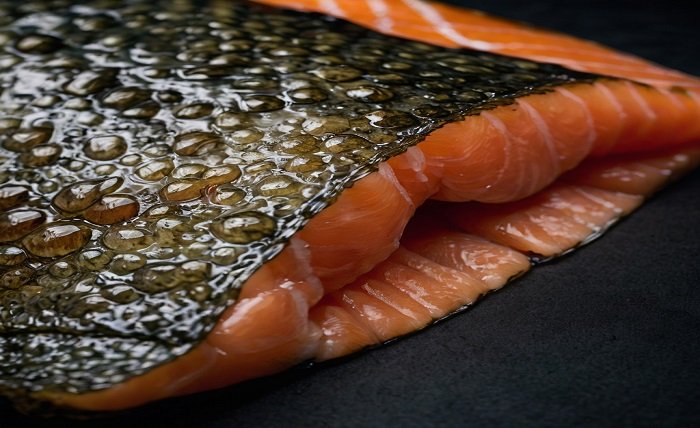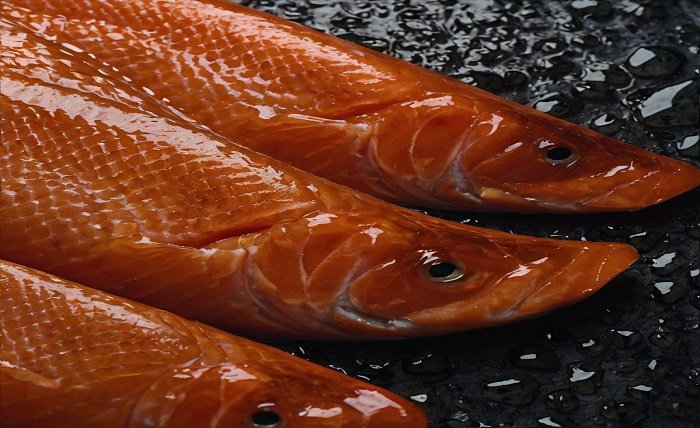Introduction
One of the most well-liked and nutrient-dense fish options is salmon. Although people frequently eat salmon flesh, many are curious about whether they can eat salmon skin. This is a crucial subject because, although salmon skin is frequently left on while cooking, consumers are unaware of its safety or nutritional value. This post will address your query by going into detail about the nutritional benefits, flavor, and preparation techniques for salmon skin. Let’s examine the reasons why eating salmon skin could have nutritional benefits for you.
Read More About: modern mullet
Nutritional Benefits of Salmon Skin

“Can you eat salmon skin?” is the question you pose. Yes, it does, and there are several nutritional advantages to it. Omega-3 fatty acids, critical for heart health, cognitive function, and inflammation reduction, are abundant in salmon skin. Salmon skin includes omega-3 fatty acids and minerals like selenium and vitamins B and D. Including salmon skin in your meal is beneficial since it contains minerals that promote general health.
Eating salmon skin adds nutrients that can help prevent heart disease and improve the appearance of your skin, in addition to providing extra calories. Therefore, leaving the skin on your salmon can be wise if you’re concerned about your health.
What Does Salmon Skin Taste Like?
You may be curious to know what salmon skin tastes like before deciding whether or not to eat it. The texture and flavor of salmon skin differ slightly from that of the fish’s flesh. When cooked properly, it turns crispy and adds a flavorful, crunchy element to the flaky, delicate salmon meat.
The skin acquires a distinct flavor when grilled or fried, which improves the dish as a whole. Some like the flavor because it’s mild enough to let the fish’s natural oils come through, while others compare it to other crispy fish skins. Try salmon skin, regardless of your preference for mild or strong flavors.
Health Risks Associated with Salmon Skin
Even so, a common question is, “Can you eat salmon skin?” It’s crucial to take any possible risks into account. Toxins like mercury and PCBs (polychlorinated biphenyls), which can build up in fish skin as a result of environmental contamination, are the main cause of concern. But compared to farmed salmon, these dangers are more common in wild fish taken from contaminated waters.
Choose wild salmon from clean streams or sustainably farmed salmon to reduce your exposure. The benefits of consuming salmon skin frequently outweigh the risks, provided that you know the source of your fish.
How to Prepare and Cook Salmon Skin
If you’ve determined that the answer to the question “Can you eat salmon skin?” is in the affirmative, you should know how to cook it properly. Frying or grilling salmon skin to a crispy texture is one of the most common methods of cooking it. Cook the skin-side down in a hot skillet or on the grill after patting it dry to get the ideal crisp.
Baking is an additional technique that can produce crispy results while using less oil. Just sprinkle some salt and pepper on the skin and bake it. Sushi enthusiasts frequently incorporate raw salmon skin into their rolls, which adds a chewy, delectable touch.
Should You Remove the Skin Before Cooking?
When someone asks, “Can you eat salmon skin?” a common response is, “Yes, but should I remove the skin before cooking?” Your cooking style and personal preferences will determine the answer to a considerable extent. Leaving the skin on adds extra flavor and prevents the salmon’s delicate meat from overcooking when cooking it on a grill or skillet.
However, you can remove the skin before cooking if you’d rather have a different texture or don’t like crispy skin. Just keep in mind that removing the skin will result in the loss of its nutritional value.
Is Eating Salmon Skin Sustainable?
In a world where environmental consciousness is growing, a common question is, “Is it possible to eat salmon skin and still be eco-friendly?” Indeed, is the response. One of the best ways to minimize food waste is to consume salmon skin. The skin is usually thrown out, but if you include it in your diet, you’re utilizing the whole fish.
Selecting salmon that is sourced sustainably is also very important. Seek out responsibly farmed or harvested salmon to make sure you’re supporting eco-friendly methods. This will allow you to eat your salmon guilt-free, skin and all.
Best Cooking Methods for Salmon Skin
“Can you eat salmon skin?” is definitely true when it comes to cooking, particularly if you know the finest methods. Baking, pan-frying, and grilling are some of the greatest ways to enhance the flavor of salmon skin.
Heating the grill: place the salmon skin-side down, and cook until it becomes crispy.
skillet-frying: Add oil to a heated skillet and cook the skin-side until it becomes crispy.
Baking: Put the skin of the salmon on a baking pan, rub it with some salt, and roast over high heat.
You can eat salmon skin in a variety of ways since each approach uniquely enhances the flavor and texture.
Conclusion
Can you eat salmon skin: Can you therefore eat salmon skin? Of course! Salmon skin is an excellent source of vitamins, minerals, and omega-3 fatty acids. It is also safe to eat. There is a cooking method to suit your preference, be it raw in sushi or crispy from the grill. Toxins can pose certain hazards; however, selecting salmon from sustainably farmed sources helps to allay worries. For those who enjoy seafood, eating salmon skin is a tasty, sustainable, and healthful option.
Read More About: technewztop
FAQ
Is it okay to eat salmon skin?
Yes, salmon skin is safe to consume when taken from clean waters and prepared correctly.
Is raw salmon skin edible?
Yes, provided the fish is fresh and prepared correctly, raw salmon skin is safe to consume and is frequently used in sushi.
Does mercury exist in salmon skin?
Although salmon skin is typically thought to have less mercury than other fish, it may contain traces of the metal.
How can the skin of salmon be made crispy?
Cook the salmon skin-side down in a hot pan or on the grill to get crispy skin.

